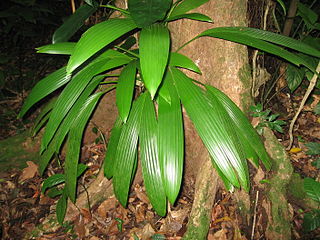
Asplundia is a genus of plants belonging to the family Cyclanthaceae. They are distributed in the Neotropical realm from southern Mexico to southern Brazil.
Asplundia albicarpa is a species of plant belonging to the family Cyclanthaceae. It has a long stem up to 2 m long with petioles up to 52 cm long carrying broad bifid leaves up to 65 cm long. It can be distinguished from most of its congeners by its fruit which remain white or greenish white when mature. A. albicarpa grows both as an epiphyte and as a terrestrial plant.
Asplundia cayapensis is a species of plant in the Cyclanthaceae family. It is endemic to Ecuador. Its natural habitats are subtropical or tropical moist lowland forests and subtropical or tropical moist montane forests.
Asplundia clementinae is a species of plant in the Cyclanthaceae family. It is endemic to Ecuador. Its natural habitat is subtropical or tropical moist lowland forests.
Asplundia cuspidata is a species of plant in the Cyclanthaceae family. It is endemic to Ecuador. Its natural habitat is subtropical or tropical moist montane forests.
Asplundia domingensis is a species of plant in the Cyclanthaceae family. It is endemic to Ecuador. Its natural habitat is subtropical or tropical moist lowland forests.
Asplundia fagerlindii is a species of plant in the Cyclanthaceae family. It is endemic to Ecuador. Its natural habitats are subtropical or tropical moist lowland forests and subtropical or tropical moist montane forests.
Asplundia helicotricha is a species of plant in the Cyclanthaceae family. It is endemic to Ecuador. Its natural habitats are subtropical or tropical moist lowland forests and subtropical or tropical moist montane forests.
Asplundia lilacina is a species of plant in the Cyclanthaceae family. It is endemic to Ecuador. Its natural habitat is subtropical or tropical moist montane forests.
Asplundia lutea is a critically endangered species of plant in the Cyclanthaceae family. It is endemic to Ecuador. Its natural habitat is subtropical or tropical moist lowland forests.
Asplundia nonoensis is a species of plant in the Cyclanthaceae family. It is endemic to Ecuador. Its natural habitat is subtropical or tropical moist montane forests.
Asplundia pastazana is a species of plant in the Cyclanthaceae family. It is endemic to Ecuador. Its natural habitat is subtropical or tropical moist montane forests.
Asplundia quinindensis is a species of plant in the Cyclanthaceae family. It is endemic to Ecuador. Its natural habitats are subtropical or tropical moist lowland forests and subtropical or tropical moist montane forests.
Asplundia sparrai is a species of plant in the Cyclanthaceae family. It is endemic to Ecuador. Its natural habitat is subtropical or tropical moist montane forests.
Asplundia truncata is a species of plant in the Cyclanthaceae family. It is endemic to Ecuador. Its natural habitat is subtropical or tropical moist montane forests.

Helicia is a genus of 110 species of trees and shrubs, constituting part of the plant family Proteaceae. They grow naturally in rainforests throughout tropical South and Southeast Asia, including India, Sri Lanka, Indochina, Peninsular Malaysia to New Guinea and as far south as New South Wales.
Gloria Amparo Galeano Garcés was a Colombian botanist and agronomist specializing in the palm family. Galeano was a faculty member at the National University of Colombia, and was the director of the Institute of Natural Sciences from 2003 to 2006. She received her Ph.D. from the University of Aarhus, Denmark in 1997.

The World's 25 Most Endangered Primates is a list of highly endangered primate species selected and published by the International Union for Conservation of Nature (IUCN) Species Survival Commission (SSC) Primate Specialist Group (PSG), the International Primatological Society (IPS), Global Wildlife Conservation (GWC), and Bristol Zoological Society (BZS). The IUCN/SSC PSG worked with Conservation International (CI) to start the list in 2000, but in 2002, during the 19th Congress of the International Primatological Society, primatologists reviewed and debated the list, resulting in the 2002–2004 revision and the endorsement of the IPS. The publication was a joint project between the three conservation organizations until the 2012–2014 list when BZS was added as a publisher. The 2018–2020 list was the first time Conservation International was not among the publishers, replaced instead by GWC. The list has been revised every two years following the biannual Congress of the IPS. Starting with the 2004–2006 report, the title changed to "Primates in Peril: The World's 25 Most Endangered Primates". That same year, the list began to provide information about each species, including their conservation status and the threats they face in the wild. The species text is written in collaboration with experts from the field, with 60 people contributing to the 2006–2008 report and 85 people contributing to the 2008–2010 report. The 2004–2006 and 2006–2008 reports were published in the IUCN/SSC PSG journal Primate Conservation,, since then they have been published as independent publications.

Sparganocosma is a genus of moths in the family Tortricidae. It contains only one species, Sparganocosma docsturnerorum, which is found in north-western Costa Rica.

Moqri Kola is a village in Khvosh Rud Rural District, Bandpey-ye Gharbi District, Babol County, Mazandaran Province, Iran. At the 2006 census, its population was 385, in 94 families.





